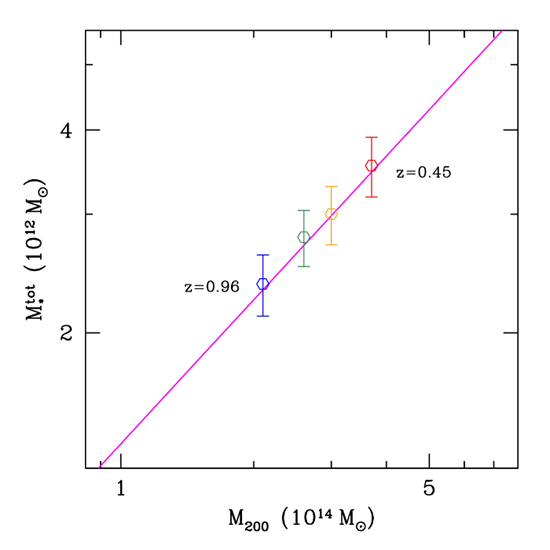研究成果藝廊 > SUBARU 望遠鏡計畫(SUBARU)
研究成果藝廊
SUBARU 望遠鏡計畫(SUBARU)
| Subaru conducts latest population census of galaxy clusters |
|
圖片來源: Yen-Ting Lin et al. (2017, ApJ, 851, 139)

The total stellar mass in a cluster, plotted on the y-axis, is found to be proportional to the total mass of the cluster (shown on the x-axis). What is more surprising is that the proportionality does not seem to evolve with time (the 4 points in the Figure represent clusters at 4 different cosmic epochs). More theoretical studies are needed to understand the origin of such a lack of evolution of this scaling relation.
|
| Galaxy clusters, composed of thousands of galaxies, are the largest structures bound by gravity in the universe. The goal of our study is to uncover how cluster galaxies evolve, and could be thought of as to understand how a city is built with time, if we identify a cluster as a city, and cluster galaxies as its citizens. As cities often start as small villages and grow by agglomeration with other towns, clusters also start small and grow via mergers with other clusters and groups of galaxies. As cities grow in size, the typical trades of the citizens may also change; we also observe changes in the properties of cluster galaxies at different stages in the lives of clusters.
We have quantified the evolution of the relative proportion of galaxies of different stellar mass and color (similar to conducting a census of citizens in cities). Our key finding is that the total stellar mass in a cluster (y-axis of Figure) is proportional to the total mass of the cluster (x-axis) and, surprisingly, the proportionality does not seem to evolve with time (the 4 points in Figure represent clusters at 4 different epochs). In our city analogy, it is like finding that the total population in a city is in proportion to the total area of the city, and the ratio of the area to the number of people is the same throughout the history (which may be surprising as people live in different kinds of buildings as time goes). Our result thus puts strong constraints on how galaxies evolve in the cluster environments, and how clusters merge with other galactic systems |
 asiaa.sinica.edu.tw 媒體連絡: epo
asiaa.sinica.edu.tw 媒體連絡: epo asiaa.sinica.edu.tw
asiaa.sinica.edu.tw